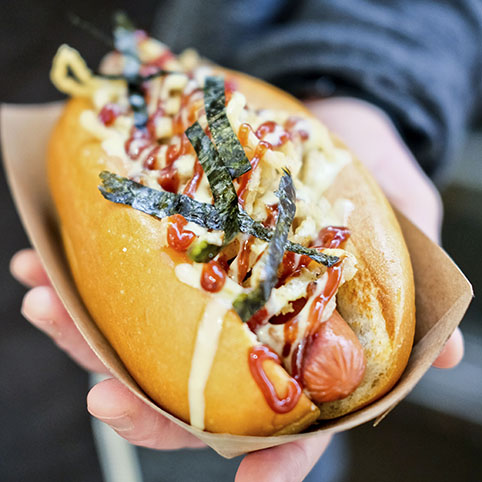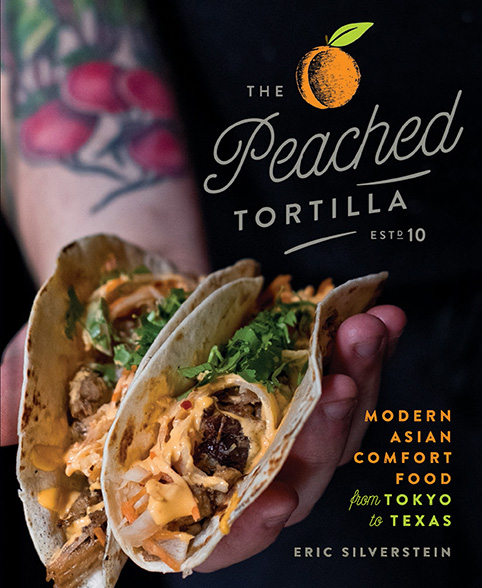
Yume Dog. Photo: Carli Rene
Asian street food with a Southern twist is a hot idea for summer.
A cross-kitchen between Tokyo and Texas may seem unlikely but author Eric Silverstein will make you a fan through his new book, The Peached Tortilla. Silverstein’s draws from his Asian food culture background and later from his immersion in Southern and Southwestern cuisine to write this new cookbook based on recipes from his hip restaurant, The Peached Tortilla located in Austin, Texas.
The edgy-style cookbook is loaded with 100 recipes and many beautiful photos. Signature dish recipes are here like the Banh Mi Taco, Japajam Burger and Bacon Jam Fries. The Peached Tortilla is Asian fusion at its best intertwined with soul-satisfying comfort food with a kick.
Silverstein did not take the traditional route into the hospitality world. The former litigator always had a passion for food and aspired to become an entrepreneur, so he decided to combine the two by opening a food truck.
 His first truck opened in Austin in September 2010 and The Peached Tortilla empire has since expanded into a fleet of food trucks, three brick-and-mortar restaurants, and a full-service catering business and event space, Peached Social House. He opened a new fast casual outpost of The Peached Tortilla in the Austin-Bergstrom International Airport in the spring of 2018 and his most recent project, Bar Peached, opened January 2019.
His first truck opened in Austin in September 2010 and The Peached Tortilla empire has since expanded into a fleet of food trucks, three brick-and-mortar restaurants, and a full-service catering business and event space, Peached Social House. He opened a new fast casual outpost of The Peached Tortilla in the Austin-Bergstrom International Airport in the spring of 2018 and his most recent project, Bar Peached, opened January 2019.
Silverstein was born in Tokyo, Japan, where he lived for 1 years before moving to Atlanta, GA. At age 27, he moved to Austin. It was his upbringing in both the Peach State and his “atypical” approach to food that inspired him too name his business, “The Peached Tortilla.”
His style of cooking is heavily influenced by Japanese, Chinese and Malaysian cuisine from his time growing up in Japan with hints of flavors from his time spent in the South.
Hot dog lovers will delight with his fun recipe “Yume Dog.” According to Silverstein, “creating a Japanese-inspired hot dog was by no means my idea.” He wanted to combine the all American hot dog with the Japanese flavors of tonkatsu sauce, wasabi and nori. He suggests a light weight bun that does not overpower this Asian-fusion dog topped with tempura-battered onion strings, wasabi mayo, tonkatsu sauce and shredded nori (dried seaweed sheets).
Yume Dog
Makes 4 servings
4 hot dogs
1/2 tablespoon vegetable oil
4 jumbo Hebrew National® kosher all beef franks
2 cups, Tempura-Battered Onion Strings (see recipe below)
4 tablespoons Wasabi Mayo (see recipe below)
4 tablespoons Tonkatsu Sauce (see recipe below)
¼ cup + 2 tablespoons Kimchi, pureed
¼ cup shredded Nori
Using a serrated knife, slice the buns from the top as opposed to the side. You will be laying the hot dog into the bun from the top, as you would layer lobster into a Connecticut lobster role.
In a medium-sized skillet, heat the oil over medium heat and lay the hot dogs in the pan. Turn the hot dogs so that they cook on all sides. This should take about 4 minutes. Remove the hot dogs from the heat and transfer them to a separate plate.
In the same pan in which you cooked the hot dogs, lay the buns, split side down, until they brown a little. Once they have browned, flip the buns to toast the other sides.
Remove the buns from the pan and stuff the hot dogs into the buns.
Lay the tempura-battered onion strings on top of the hot dogs. Then top the hot dogs with the wasabi mayo, tonkatsu sauce, and shredded nori.
Tempura-Battered Onion Strings
Makes about 2 cups
2 quarts vegetable oil
1 yellow onion, sliced very thinly, widthwise, on a mandolin
12 ounces Shiner Block® or another American-style dark lager
1 cup dry Tempura mix
To Make the Tempura-Battered Onion Strings:
Pour the oil into a large, deep saucepan or pot, and heat the oil until it reaches 350 F degrees.
Soak the sliced onion in the lager, and then remove it. Dredge the wet onion on the tempura batter. Gently shake the onion in a fine mesh strainer or colander to release any excess batter. When the oils reaches 350 F degrees, place the onion in the hot oil and fry it for 20 seconds, or until it is lightly browned. Remove the inion strings from the oil and place them on top of a paper towel-line plate.
Wasabi Mayo
Makes 1 1/2 cups
1 cup mayonnaise
2 tablespoons Dijon mustard
2 tablespoons prepared wasabi paste (see Note)
¾ tablespoon lime juice
½ teaspoon sesame oil
Place all the ingredients in a mixing bowl and whisk them together. Store the mayo in an airtight container in the refrigerator for up to a month.
Note: if you are using wasabi powder, mix it with cold water to create a paste. The strength of the wasabi paste is the biggest variable in this recipe. The stronger the paste, the stronger the mayo. After you’ve made the paste, taste it to make sure it’s not overpowering. I recommend using a ratio of 1 teaspoon of wasabi powder to 1 teaspoon of cold water.
Tonkatsu Sauce
Makes about 2 cups
1 ½ cups tomato ketchup
1/3 cup soy sauce
3 tablespoons Worcestershire sauce
2/3 cup brown sugar
½ cup sugar
½ teaspoon garlic powder
½ teaspoon freshly ground pepper
1 ½ tablespoons cornstarch slurry (mix ¾ tablespoon cornstarch with ¾
tablespoon cold water)
Place all the ingredients in a small saucepot and stir them together.
Place the saucepan on the stovetop and bring the mixture to a boil.
Once the mixture starts to boil, turn the heat down to a simmer.
Simmer the mixture for 40 minutes. Do not overcook the mixture and let it reduce too much or the resulting sauce will be too salty.
Store the Tonkatsu Sauce in an airtight container in the refrigerator for 4-5 days.













